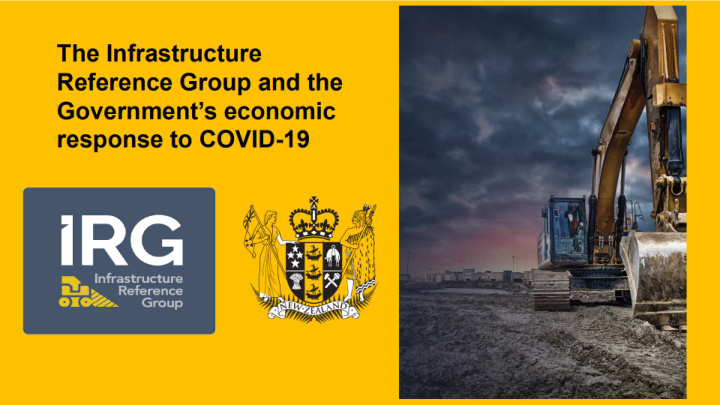



About the Infrastructure Reference Group process: • The Infrastructure Reference Group ( IRG ) was established in response to the COVID-19 crisis and its impact on the infrastructure and construction sectors. • It was asked to prepare a pipeline of ‘shovel ready’ projects which could get underway within 12 months and create and protect jobs for New Zealanders. • An additional $3 billion was allocated for infrastructure in Budget 2020. • The infrastructure sector is about 13 per cent of GDP and directly employs more than 500,000 people. • The IRG sought out projects over $10 million, which would have a stimulatory effect on the industry, its workforce and the economy. • A total of 1,924 projects with a combined value of $134 billion were received. • A report was delivered to Ministers on 18 May which included a refined shortlist of 802 projects. • The IRG applied the following criteria to create its list of projects: • construction readiness; • direct employment; and • national and regional benefit.
COVID-19 impacts on the economy: • IRG commissioned Infometrics to assess the economic impact of COVID-19. It forecasted: • Otago GDP to decline 10% (Queenstown >23%); • West Coast GDP by 9.5%; • Auckland GDP by >9.5%, • Tourist reliant areas, like Queenstown-Lakes and Mackenzie District, forecast to decline by more than 20%. • Regions with large agricultural/food processing sectors including Hawke’s Bay, Manawatu-Whanganui, and Gisborne are expected to experience less of a downturn. • Areas with high concentrations of tourism and construction will take the hardest relative declines in job losses, however, largest losses will occur in major cities. • Infometrics estimates the value of residential building to decline by 19% and non-residential work to decline by 18% to March 2021.
The IRG and the Government’s priorities: Infrastructure investment must support our transition towards to a more productive, sustainable and inclusive economy, enable • our regions to grow, and support a modern and connected New Zealand. It should also provide jobs for New Zealanders, so they can continue to provide for themselves and their families. • This is about creating certainty in the sector and jobs in both the short and longer term. • The full package represents a focus on the following key sectors: • Housing and Urban Development : Focus on the Urban Growth Agenda and the key economic shift to transform our housing market to unlock productivity growth and make houses more affordable. This includes horizontal and vertical infrastructure necessary to support increased housing supply. Energy : Focus on key economic shift to sustainable and affordable energy systems. Community Development : (including small scale projects): focus on supporting strong and revitalised communities in both cities and regions Climate Resilience and Flood Protection : focus on key economic shift so that land and resource use delivers greater value and improves environmental outcomes, which could include flood protection and water storage. Central and Local Government infrastructure : focus on the Government’s wider objectives, and support the recovery.
What we’re delivering: A $2.6 billion programme of investment undertaken in partnership with local government and business: • Over 150 projects across every region in the country, agreed in principle by Cabinet: • Over 20,000 jobs predicted to be created • Over $5 billion of investment in total • A pipeline of work starting immediately and running through to the end of 2022 This includes: • Housing and urban development: $464m • Environmental: $460m • Community and social development: $670m • Transport (cycleways, walkways, ports and roads): $708m These investments will build on the significant infrastructure investment already undertaken by the Government, including through the New Zealand Upgrade Programme and the Provincial Growth Fund.
Recommend
More recommend